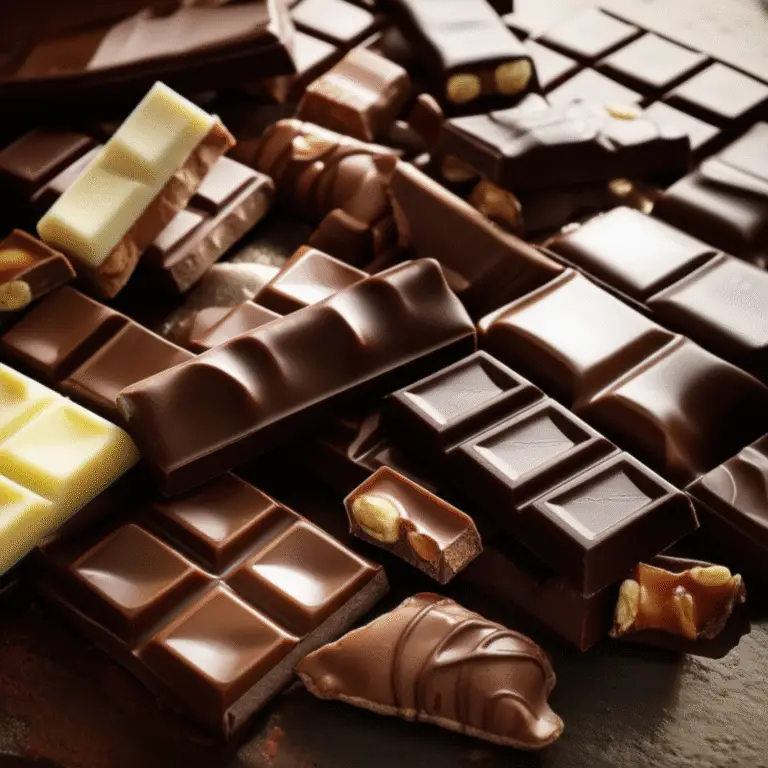Support our educational content for free when you purchase through links on our site. Learn more
Does 100% Chocolate Expire? 🍫 The Truth Revealed (2025)
Ever stumbled upon a forgotten bar of 100% chocolate in your pantry and wondered, “Is this still good?” You’re not alone! Pure cacao bars, known for their intense bitterness and health benefits, often come with a “best by” date—but does that mean they actually expire? Spoiler alert: the answer isn’t as simple as you might think. In this article, we’ll unravel the mystery behind the shelf life of 100% chocolate, reveal how to spot if your bar has gone bad, and share expert storage tips that can extend its life well beyond the date on the wrapper.
Did you know that unlike milk or sweetened chocolates, 100% pure cacao bars can remain safe to eat for years if stored properly? But beware—the infamous “chocolate bloom” might make your bar look unappetizing, even though it’s perfectly fine to eat. Curious how to tell the difference between harmless bloom and actual spoilage? Keep reading, because our expert tasters at Chocolate Brands™ have all the answers, plus insider tips on maximizing your chocolate investment and creative ways to use older bars.
Key Takeaways
- 100% chocolate typically doesn’t expire but has a “best by” date indicating peak quality, not safety.
- Proper storage—cool, dry, and airtight—is essential to prevent rancidity and bloom.
- White or grayish “bloom” on chocolate is harmless fat or sugar crystallization, not mold.
- Use your senses: if the chocolate smells rancid, tastes off, or shows mold, it’s time to toss it.
- Freezing 100% chocolate is possible but may cause texture changes; thaw slowly to avoid condensation.
- Older or bloomed bars can be repurposed in baking, hot cocoa, or sauces to avoid waste.
Ready to become a 100% chocolate longevity pro? Dive into our full guide and never fear that forgotten bar again!
Table of Contents
- ⚡️ Quick Tips and Facts: Your 100% Chocolate Cheat Sheet
- 🍫 The Enduring Enigma: Unpacking the Shelf Life of 100% Cacao Chocolate
- 🗓️ Decoding the Dates: “Best By” vs. “Expiration” on Your Pure Chocolate Bar
- 👀 Signs Your 100% Chocolate Might Be Past Its Prime (But Probably Still Edible!)
- 🌡️ Mastering the Art of Storage: Maximizing the Life of Your 100% Chocolate
- ✅❌ Is It Safe to Eat? Our Taster’s Verdict on “Expired” 100% Chocolate
- 💰 Savvy Cacao Consumption: Getting the Most Out of Your 100% Chocolate Investment
- 🌍 Beyond the Bar: 100% Cacao in Other Forms (and Their Shelf Lives)
- 🧐 Our Expert Recommendations: Top 100% Chocolate Brands We Trust
- Conclusion: The Timeless Appeal of Pure Cacao
- Recommended Links: Dive Deeper into the World of Chocolate
- FAQ: Your Burning Questions About 100% Chocolate’s Longevity, Answered!
- Reference Links: Our Sources and Further Reading
⚡️ Quick Tips and Facts: Your 100% Chocolate Cheat Sheet
If you’ve ever found a lonely bar of 100% chocolate hiding in your pantry and wondered, “Does 100 chocolate expire?” — you’re in the right place! At Chocolate Brands™, we’ve tasted, tested, and stored pure cacao bars so you don’t have to guess.
Here’s a quick rundown to keep you on track:
| Aspect | Insight |
|---|---|
| Shelf Life | Typically 1-2 years unopened; quality slowly declines after “best by” date |
| Expiration vs. Best By Date | 100% chocolate usually has a best by date, not a strict expiration date |
| Signs of Spoilage | White bloom (fat or sugar), off smells, mold (rare), texture changes |
| Storage Tips | Cool (60-70°F), dry, dark place; airtight packaging; avoid fridge unless very humid |
| Freezing | ✅ Possible but may cause bloom; thaw slowly at room temp before opening |
| Safety | Usually safe to eat after best by if no off smell or mold; taste test is key |
For a deep dive on chocolate longevity, check out our related article on Can you eat 100 year old chocolate?.
Ready to unravel the mystery? Let’s dig in! 🍫
🍫 The Enduring Enigma: Unpacking the Shelf Life of 100% Cacao Chocolate
What Exactly Is 100% Chocolate? A Pure Cacao Deep Dive
Before we talk expiration, let’s clarify: 100% chocolate means pure cacao — no sugar, milk, or additives. It’s the raw essence of the cacao bean, often called baking chocolate or unsweetened chocolate.
- Composition: Pure cacao solids + cocoa butter (natural fat)
- Flavor: Intense, bitter, earthy — not for the faint-hearted!
- Uses: Baking, cooking, health-conscious snacking
Because it lacks sugar and dairy, which can spoil faster, 100% chocolate behaves differently than your average milk or dark chocolate bar.
The Science of Shelf Life: Why Chocolate Lasts (Mostly)
Chocolate’s longevity stems from its low moisture content and high fat. Moisture is the enemy of spoilage, so dry chocolate resists bacteria and mold growth.
- Cocoa butter can oxidize over time, causing rancidity — but this takes a while.
- Flavonoids in cacao act as natural antioxidants, slowing degradation.
- Storage conditions (temperature, humidity, light) are critical.
According to Food Thoughts, cocoa powder and chocolate can last years if stored properly — but quality fades.
🗓️ Decoding the Dates: “Best By” vs. “Expiration” on Your Pure Chocolate Bar
Understanding “Best By” Dates: A Quality Indicator, Not a Doom Clock
Most 100% chocolate bars sport a best by date, not an expiration date. This means:
- The manufacturer guarantees peak flavor and texture until that date.
- Afterward, the chocolate may lose aroma, smoothness, or flavor intensity.
- It’s not a safety cutoff.
Think of it like a concert ticket: best by means the show is best before this date, but you can still attend after (maybe with a few less fireworks).
When an “Expiration Date” Might Matter for Cacao Products
Expiration dates are rare on pure chocolate but common on products with dairy or added ingredients. For 100% chocolate:
- Expiration dates might appear on chocolate spreads or filled bars.
- If you see one, treat it seriously — these products can spoil.
- For pure bars, rely on sensory checks instead.
👀 Signs Your 100% Chocolate Might Be Past Its Prime (But Probably Still Edible!)
1. The Infamous Chocolate Bloom: Fat Bloom vs. Sugar Bloom
Ever noticed white or grayish patches on your chocolate? That’s bloom, and it’s harmless but can affect texture and taste.
| Type | Cause | Appearance | Impact on Safety | How to Fix/Prevent |
|---|---|---|---|---|
| Fat Bloom | Cocoa butter separates and recrystallizes | White, streaky, waxy | ❌ Safe | Store at consistent cool temps; re-temper if baking |
| Sugar Bloom | Moisture dissolves sugar, then recrystallizes | Grainy, powdery white | ❌ Safe | Avoid humidity; keep airtight |
2. A Whiff of Trouble: Detecting Rancidity in Pure Cacao
If your chocolate smells off, sour, or like old nuts, rancidity may have set in. This happens when cocoa butter oxidizes.
- Rancid chocolate tastes bitter and unpleasant.
- It’s not toxic but not enjoyable.
- Toss it if the smell or taste is strongly off.
3. The Uninvited Guest: Mold on Chocolate
Mold on chocolate is rare due to low moisture, but if your chocolate has visible mold spots, discard immediately.
- Mold can develop if stored in damp or humid conditions.
- Never scrape mold off and eat the rest.
4. Texture Troubles: Dry, Crumbly, or Too Soft?
- Dry or crumbly: Could be old or stored improperly.
- Too soft or melting: Stored in warm conditions.
- Texture changes don’t always mean unsafe but can affect enjoyment.
🌡️ Mastering the Art of Storage: Maximizing the Life of Your 100% Chocolate
The Ideal Environment: Temperature, Humidity, and Light
To keep your pure chocolate happy:
- Temperature: 60-70°F (15-21°C) is ideal. Avoid fluctuations.
- Humidity: Below 50% to prevent sugar bloom.
- Light: Keep away from direct sunlight to prevent fat oxidation.
Packaging Perfection: Keeping Air and Odors Out
Chocolate is a great odor absorber — so store it in airtight containers or wrap tightly in foil/plastic wrap.
- Avoid storing near strong-smelling foods (onions, spices).
- Vacuum sealing is a pro tip for long-term storage.
Can You Freeze 100% Chocolate? Our Expert Take!
Freezing chocolate is a debated topic. Our tasters say:
✅ You can freeze 100% chocolate if you:
- Wrap it tightly to prevent moisture.
- Thaw slowly at room temperature to avoid condensation.
❌ But beware:
- Freezing can cause fat bloom.
- Texture might change slightly.
If your kitchen is a sauna, freezing might be your best bet!
✅❌ Is It Safe to Eat? Our Taster’s Verdict on “Expired” 100% Chocolate
The “Sniff and Taste” Test: Your First Line of Defense
We always say: trust your senses.
- Smell: No sour, rancid, or moldy odors? ✅
- Look: No mold or excessive bloom? ✅
- Taste: Bitter but not off? ✅
If it passes, it’s safe to eat, even months past the best by.
When to Toss It: Prioritizing Food Safety
- Visible mold? ❌ Toss.
- Strong rancid smell or taste? ❌ Toss.
- Signs of moisture damage or insect infestation? ❌ Toss.
Remember, your health always comes first!
💰 Savvy Cacao Consumption: Getting the Most Out of Your 100% Chocolate Investment
Creative Uses for Less-Than-Perfect Pure Chocolate
Don’t throw out that bloomed or slightly stale bar! Here’s what to do:
- Bake with it: Chocolate bloom disappears when melted.
- Make hot cocoa: Pure cacao powder or melted chocolate works wonders.
- Add to smoothies: Boost antioxidants and flavor.
- DIY chocolate sauces or ganache: Texture flaws vanish once melted.
Bulk Buying and Smart Storage Strategies
- Buy from trusted brands like Valrhona, Ghirardelli, or Michel Cluizel for quality and consistent shelf life.
- Store unopened bars in a cool, dark pantry.
- Portion into smaller wraps once opened to reduce air exposure.
🌍 Beyond the Bar: 100% Cacao in Other Forms (and Their Shelf Lives)
Cacao Nibs: The Crunchy, Long-Lasting Powerhouse
- Shelf life: 1-2 years unopened.
- Storage: Airtight, cool, dry place.
- Use: Baking, toppings, snacking.
- Nibs have less fat than bars, so less risk of rancidity.
Pure Cacao Powder: Storage Secrets for Your Baking Pantry
- Can last 2-3 years unopened.
- Store in airtight container away from moisture.
- Clumping or slight discoloration is normal but check for mold.
- Freezing is optional but not necessary.
Cacao Paste/Liquor: Culinary Versatility and Longevity
- Shelf life: About 1 year unopened.
- Storage: Cool, dry place, airtight.
- Used in gourmet cooking and chocolate making.
- Higher fat content means watch for rancidity signs.
🧐 Our Expert Recommendations: Top 100% Chocolate Brands We Trust
| Brand | Flavor Intensity | Packaging | Shelf Life | Availability | Notes |
|---|---|---|---|---|---|
| Valrhona | 9/10 | 8/10 | 2 years | Widely sold | Premium quality, smooth texture |
| Ghirardelli | 8/10 | 9/10 | 1.5 years | Very common | Reliable, consistent flavor |
| Michel Cluizel | 9/10 | 7/10 | 2 years | Specialty | Artisan, complex flavor profile |
| Lindt | 7/10 | 8/10 | 1.5 years | Widely sold | Accessible, slightly milder |
| Guittard | 8/10 | 7/10 | 2 years | Specialty | Great for baking and cooking |
Why these brands? They use high-quality cacao, have good packaging to protect freshness, and offer consistent taste — crucial for pure chocolate lovers.
👉 CHECK PRICE on:
- Valrhona 100% Chocolate – Amazon
- Ghirardelli Unsweetened Baking Chocolate – Amazon
- Michel Cluizel 100% Chocolate – Official Website
Conclusion: The Timeless Appeal of Pure Cacao
So, does 100% chocolate expire? The short answer: not exactly. Pure cacao bars don’t have a hard expiration date but a best by date that signals peak quality rather than safety. Our expert tasters at Chocolate Brands™ confirm that with proper storage—cool, dry, and airtight—100% chocolate can remain safe and enjoyable well beyond that date.
Positives of 100% Chocolate:
- Long shelf life due to low moisture and natural antioxidants
- Versatile for baking, cooking, and health-conscious snacking
- Pure, intense flavor with no additives or sugar
- Less prone to spoilage than milk or sweetened chocolates
Negatives:
- Can develop fat or sugar bloom affecting texture and appearance
- Rancidity possible if stored improperly or too long
- Intense bitterness may not be for everyone
- Sensitive to humidity and temperature fluctuations
Our confident recommendation? Invest in high-quality brands like Valrhona, Michel Cluizel, or Ghirardelli, store your bars smartly, and don’t fear the bloom—it’s just chocolate’s way of aging gracefully. If you find a bar past its best by date, trust your senses: if it smells good and tastes fine, enjoy it! Otherwise, repurpose it in recipes or say goodbye.
Remember, chocolate is a journey, not a race. Your 100% chocolate might just outlast your cravings!
Recommended Links: Dive Deeper and Shop Smart
👉 Shop Top 100% Chocolate Brands:
- Valrhona 100% Chocolate: Amazon | Valrhona Official Website
- Ghirardelli Unsweetened Baking Chocolate: Amazon | Ghirardelli Official Website
- Michel Cluizel 100% Chocolate: Michel Cluizel Official Website
Books for Chocolate Lovers:
- The True History of Chocolate by Sophie D. Coe & Michael D. Coe — Amazon
- Chocolate: A Bittersweet Saga of Dark and Light by Mort Rosenblum — Amazon
- The Chocolate Lover’s Companion by Sharon Terenzi — Amazon
FAQ: Your Burning Questions About 100% Chocolate’s Longevity, Answered!
How long does 100% chocolate last before it expires?
100% chocolate typically lasts 1 to 2 years unopened when stored properly. Unlike perishable foods, it usually carries a best by date rather than an expiration date, indicating peak quality rather than safety. After this date, flavor and texture may decline but it remains safe if stored well. For more on chocolate shelf life, see Food Thoughts.
Read more about “Can You Eat Chocolate 2 Years Out of Date? 🍫 What You Need to Know (2025)”
Can expired 100% chocolate still be eaten safely?
Yes! If your 100% chocolate is past its best by date but shows no signs of mold, rancidity, or off odors, it is generally safe to eat. The bitterness might be stronger, and texture may change, but it’s not harmful. Always perform a sniff and taste test before indulging.
What are the signs that 100% chocolate has gone bad?
Look for these red flags:
- Mold: Visible fuzzy or colored spots — discard immediately.
- Rancid smell: Sour, stale, or “off” odors from fat oxidation.
- Severe texture changes: Excessive crumbling or melting.
- Unpleasant taste: Sour, musty, or otherwise off flavors.
White bloom (fat or sugar) is common and safe but may affect texture.
Read more about “What Happens If You Eat Expired Milk Chocolate? 9 Surprising Facts 🍫 (2025)”
How should 100% chocolate be stored to extend its shelf life?
Store in a cool (60-70°F), dry, and dark place with low humidity (<50%). Keep chocolate in airtight packaging to avoid moisture and odor absorption. Avoid refrigeration unless your environment is very hot and humid; if freezing, wrap tightly and thaw slowly at room temperature to prevent condensation.
Can I freeze 100% chocolate?
Freezing is possible but may cause fat bloom and slight texture changes. If you must freeze, wrap well and thaw gradually.
Does chocolate bloom mean it’s spoiled?
No! Chocolate bloom is a harmless crystallization of fat or sugar. It may affect appearance and mouthfeel but not safety.
Read more about “What Happens If You Eat Expired Dairy Milk Chocolate? 🍫 (2025 Guide)”
Reference Links: Our Sources and Further Reading
- Food Thoughts: Does Cocoa Powder Go Bad?
- Michel Cluizel Blog: Can Cocoa Powder Go Bad?
- Valrhona Official Website
- Ghirardelli Official Website
- Michel Cluizel Official Website
- Facebook Discussion: Is Hershey’s Cocoa Still Hard to Find in Stores?
For more on chocolate history and health benefits, explore our internal categories at Chocolate Brands™:
Enjoy your chocolate adventures, and remember: good chocolate is timeless, just like your sweet memories! 🍫✨









